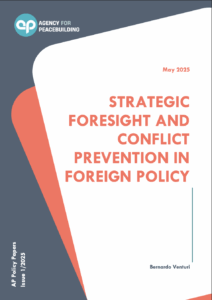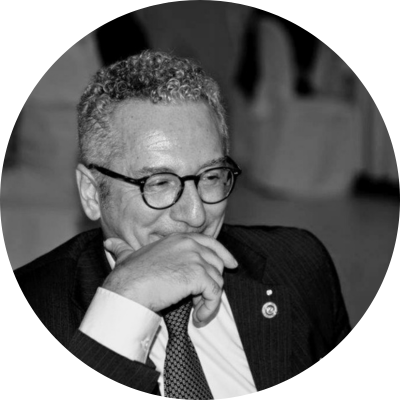Strategic Foresight and Conflict Prevention in Foreign Policy
Strategic foresight is the key to unlocking a more resilient and proactive future. It enables governments to anticipate risks and seize opportunities across various policy areas. The challenge now lies in creating a cohesive foresight ecosystem that connects national strategies with international efforts and drives impactful decision-making.
OBJECTIVES
This policy paper contributes to a better understanding of strategic foresight. Its main aim is to highlight the importance of embedding strategic foresight and early warning into foreign policy to enhance long-term planning and conflict prevention. It advocates for building a national foresight ecosystem, particularly within Italy’s Ministry of Foreign Affairs, aligned with international efforts and close to policy-making processes.
EXPERTS
Bernardo Venturi
PARTNERS
- Analysis, Programming Statistical and Historical Documentation Unit (UAP-SDS) – Directorate General for Public and Cultural Diplomacy – Italian Ministry of Foreign Affairs and International Cooperation
Background
In today’s fast-changing and interconnected world, strategic foresight represents an essential tool to be better prepared to anticipate and face future challenges. In fact, strategic foresight, together with early warning systems, empowers governments to navigate uncertainty, manage risks, and uncover emerging opportunities.
Strategic foresight is not a crystal ball, it does not predict the future. However, it can help policy makers think systematically about potential developments, and therefore it can allow to be as much aware of the future as possible. These approaches aim at moving beyond reactive problem-solving, and suggest a forward-thinking approach.
Many governments and international organisations are investing in anticipatory governance and foresight capabilities. However, this shift requires new competencies in public administration, including systems thinking, a long-term strategic vision, and innovative policymaking.
Despite growing interest, there is still limited understanding of how foresight can effectively support foreign policy and conflict prevention. With this policy paper, AP contributes to that discussion, with a focus on Italy’s emerging engagement in strategic foresight. Though still in a formative stage, Italy is beginning to adopt foresight approaches. The Italian Ministry of Foreign Affairs and International Cooperation (MAECI) is exploring ways to embed foresight into its foreign policy toolkit.
AP has elaborated this policy paper with the support of the Analysis, Programming Statistical and Historical Documentation Unit – Directorate General for Public and Cultural Diplomacy of the Ministry of Foreign Affairs and International Cooperation.
Findings
This policy paper presents interesting and compelling findings, including several recommendations directed to guiding future steps for strategic foresight in Italian foreign policy.
In order to foster a deeper comprehension of the role strategic foresight can play in supporting foreign policy and conflict prevention, this report begins by analyzing the evolution and global trends in strategic foresight, then examines its application within foreign policy, followed by a review of international models and institutions, and concludes with an exploration of Italy’s evolving approach to strategic foresight.
Final conclusions present that embedding foresight within foreign policy institutions enhances not only conflict prevention but also the overall resilience of decision-making frameworks. The MAECI is well-positioned to lead this transformation, provided investments in analytical capacity, fostered inter-ministerial collaboration, and a forward-looking organisational culture.
Among the key recommendations for establishing an effective foresight ecosystem in Italy are the strengthening of institutional foresight capabilities through dedicated resources and personnel; the promotion of national-level coordination; the integration of foresight units within close proximity to high-level decision-makers; the fostering of inclusive and participatory processes to ensure broad internal engagement; the enhancement of public and institutional awareness of foresight practices; the involvement of external stakeholders; and the prioritization of investments in conflict prevention and early warning mechanisms aligned with EU frameworks.
In conclusion, this shift requires moving from ad hoc foresight efforts to a coherent, well-integrated infrastructure rooted in policy relevance and strategic clarity.

































